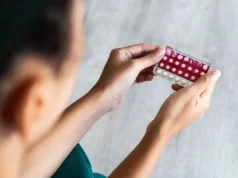The Montgomery glands or Montgomery tubercles are tiny glands around the nipples on the areola. Usually, they are not visible when a woman gets pregnant.
However, during pregnancy, the Montgomery glands often get bigger as the breasts develop to prepare for breastfeeding. They start to erupt and can look like pimples on the nipple as well as the areola.
The number of noticeable bumps on the areola is distinct for each woman. There can be anywhere from 0 to about 40 tubercles in each areola, with an average of at least 10 to 15 on each side.
In the upper, outer portion of the areola, there is more, and the size of the areola does not influence the number of glands that are there.
The function of the Montgomery Glands
Montgomery glands are a mixture of milk glands and sebaceous glands. A tiny quantity of breast milk can be released, but they often make a natural, oily material that cleans and lubricates the nipple and areola.
This oily material contains antibacterial properties. It helps protect the breasts from infection by preventing the development of microorganisms and germs.
It is suspected that the areolar glands play a significant role in having a successful start, attachment, and bonding from breastfeeding. They give off a fragrance that can help the newborn locate the nipple and enable the baby to latch on and breastfeed after birth.
Studies have found that the babies of women with more areolar glands locate the breast easier than those with less areolar glands and begin breastfeeding. Better newborn development is also correlated with more Montgomery glands.
How to care for the Montgomery Glands
Since the Montgomery glands supply your nipples with a natural moisturizer, you do not have to use lanolin or any other nipple cream to hydrate your nipples.
In addition, be careful about the soaps and other things you use while holding your breastfeeding breast. Harsh, antibacterial soaps may wash this natural defense away or interfere with it.
Here are some tips that will take care of your Montgomery glands.
- Leave them alone: Leave the Montgomery glands alone as long as the nipples and areola are smooth and stable. Clean your breasts with warm water and avoid soaps that can wash away the protective compound your Montgomery glands release.
- Consult your doctor: Ask your doctor to inspect your breasts if you have any questions about how your glands or nipples look.
- Stop popping: While these glands may look like pimples, they are not pimples on your breast. It would help if you didn’t try to pop them.
- Do not use acne medication as a treatment: Not only can your areola be dried out by acne medication, but several acne treatments are harmful. When you’re pregnant and breastfeeding, you should stop them.
- Don’t use nipple creams, lotions, or ointments on your breasts to try to avoid nipple infections: Unless you really have sore, broken nipples, or an infection, these are not necessary. The issues can also be made worse by some nipple creams. Speak to your healthcare professional before attempting to handle the issue on your own if you have a breast or nipple problem.
Symptoms of infection
The Montgomery tubercles may become blocked, inflamed, or contaminated. Check out around the nipple region for redness or painful swelling. If you note these or any other odd changes, see your physician.
If you feel some itching or rash, let your doctor know because they could be signs of a yeast infection. Make an appointment with your doctor if you notice a discharge and you are not breastfeeding.
When you find any blood or pus, visit your doctor as soon as possible. Changes in appearance around the nipple region may be a sign of breast cancer in rare cases.
Notify your doctor if you experience any other breast cancer signs, including:
- Hard lump on your breast
- Dimpling on the surface of your breast, or an “orange peel texture,” known as peau d’orange.
- Changes in your nipple size or shape
- Swollen lymph nodes in the armpit
- Unexpected Weight loss
- Changes in one breast’s form or size
- Discharge from the nipple
Removal
The Montgomery gland is ordinarily common and indicates that your breasts are working as they should. Following pregnancy and breastfeeding, the tubercles will typically shrink or fade away on their own.
Your doctor may suggest surgery if you are not pregnant or breastfeeding and you want the tubercles removed. This is a cosmetic choice, and if discomfort or inflammation is caused, it may be recommended.
Surgical treatment of the Montgomery gland requires an excision (removal of the bumps) around your areola, which would be done by your doctor. This is an outpatient process that takes about 30 minutes. Generally, hospitalization is not necessary.
After the treatment, you will find scarring—work along with your doctor to decide whether this is the right choice for you.
Home remedies
You should try the following home remedies if you’d like to reduce the scale of the Montgomery gland at home and are not pregnant or breastfeeding:
- Place a towel that’s been soaked in warm water on your nipples for about 20 minutes per night.
- Add aloe vera gel, shea butter, or cocoa butter around your nipples.
- Increase your water intake and decrease the consumption of sugar.
- Eat a balanced diet and minimize sugar as well as salt to avoid blocking issues that can increase the size of tubercles.
A common part of breast function is the Montgomery gland. Typically, they have little to think about. If you’re pregnant or breastfeeding, you and your baby will definitely benefit from it. In fact, you may not even see them most of the time.
The tubercles shouldn’t cause pain. Nevertheless, if you note any signs or symptoms, or any redness, swelling, or bleeding around your nipples, see your doctor. It would help if you also let your doctor know about any pain you might feel.












